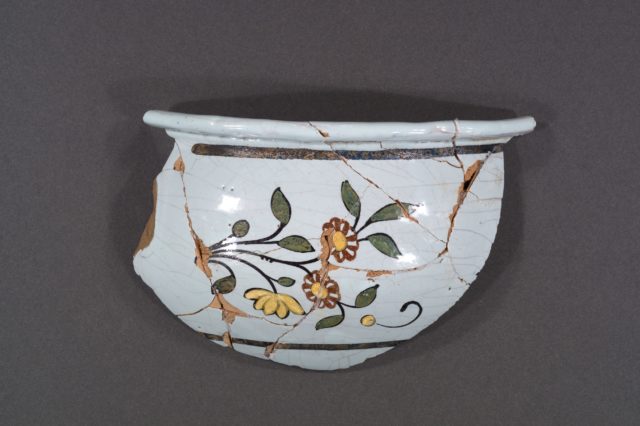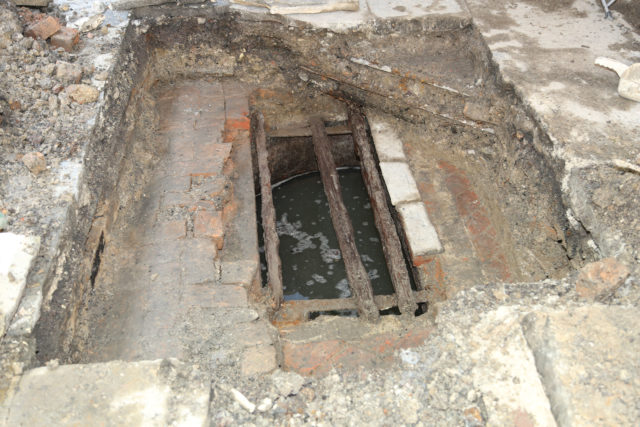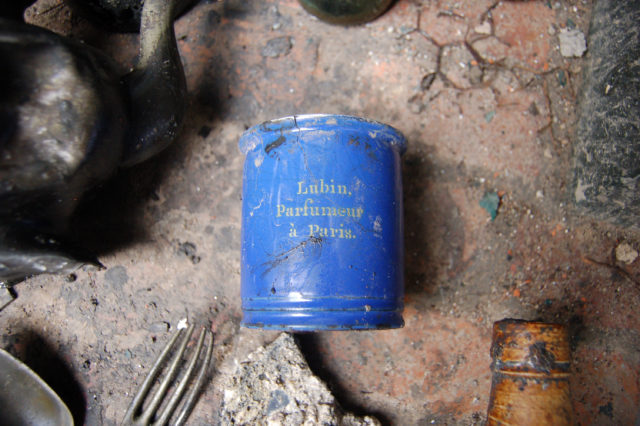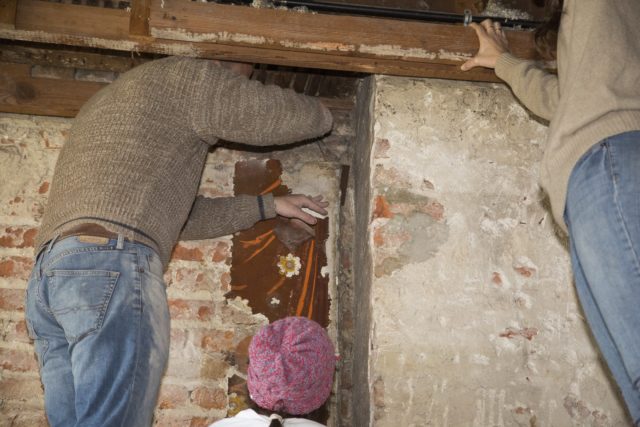A House on Royal Street
A historic renovation brings the past to the present
Published: December 1, 2019
Last Updated: March 22, 2023

Keely Merritt
The Seignouret-Brulatour building and interior courtyard after a six-year historic renovation.

The Seignouret-Brulatour building and interior courtyard before renovation. Photo by Keely Merritt, The Historic New Orleans Collection.
After several years of careful analysis, documentation, and restoration, the Seignouret-Brulatour House is now open to the public as the latest addition to The Collection’s French Quarter campus. Inside and across several floors, visitors can explore new exhibitions tracing the rich history, art, and culture of New Orleans and the Gulf South. As expansive as these new galleries are in both size and scope, understanding the specific lived history of the Seignouret-Brulatour House and site remains an important priority. “We’ve been excited to incorporate archaeological, architectural, and archival research as we restore the building and plan our exhibitions and programming there,” said Lydia Blackmore, Decorative Arts Curator at The Historic New Orleans Collection. Although the architectural fabric of the Seignouret-Brulatour House dates to after 1800, the lot on which it stands chronicles the city’s evolution from the time of its French colonial founding to the present day. Historic maps and censuses have helped to fill in the blanks and even identify the property’s first documented resident, a colonist named Jean Hardy who was living there by 1722.
Sponsored by Earth Search, Inc., a New Orleans consulting firm specializing in cultural resource management, archaeological excavations at 520 Royal Street began in 2013 under the direction of Michael Godzinski, now City of New Orleans Staff Archaeologist. “We’ve really only just begun to scratch the surface,” Godzinski said, “but in just a few years of digging, we managed to bring several thousand artifacts to light and sketch a much more complete chronology.” Some finds, like melted glass, burned ceramics, and dark-colored layers of soil, bear witness to historic events like the disastrous fires that engulfed much of the present-day French Quarter in 1788 and 1794. In comparison, intact and broken wine bottles evoke the business practices of both the Seignouret and Brulatour families, who imported large amounts of French wines.
Because they were used on a daily basis and for all kinds of activities, ceramics were among the most common type of artifact found by Earth Search archaeologists at the site. Some of the oldest sherds, or broken ceramic pieces, are from Native American pottery possibly meant for trade with French colonists, who brought their own tin-glazed earthenware ceramics, known as faïence, to Louisiana. One especially beautiful faïence fragment was found towards the back of the lot, where trash from one or more eighteenth-century households fronting Royal Street appears to have been deposited. Made in Normandy, used in New Orleans, and discarded after it was broken, the complete vessel featured a delicately hand-painted plant with three blooming flowers that can still be admired on the recovered sherds. “Not only was this a visually stunning find,” Godzinski recalled, “but the pieces were found alongside a large oyster shell, fish bones, and different fruit pits and seeds, all of which underscore the variety of colonial-era diets in New Orleans.”

18th-century trash becomes 21st-century treasure with these pieced-together fragments of a tin-glazed earthenware, or faïence, vessel recovered from a historic household trash pit. The Historic New Orleans Collection
The archaeological discovery of a brick well in the Seignouret-Brulatour courtyard has proven to be an especially revealing source of information about daily life in the second half of the nineteenth century. Visitors can see the well for themselves by peeking through a transparent glass cover. One of the artifacts found in the well—a tin can that once contained preserved quail meat and truffles imported from France—has become a special staff favorite. The can still bears an extravagant gilt label that records its former contents, which, along with a can of sardines in oil and other delicacies, was possibly sold by Brulatour. Blackmore explained, “This single artifact paints an especially rich picture, one spanning the demand for luxury goods in the Gulf South to the legendary culinary heritage of New Orleans.” A sampling of these and other artifacts is now on view in one of the building’s new galleries, where hands-on components and digital media help explain how archaeological work is performed.

A brick well dating to the mid-19th century found beneath multiple layers of brick and flagstones. Now uncovered, the well is a prominent feature of the new museum complex. Photo by Akasha Rabut, The Historic New Orleans Collection
Over the course of the restoration, the Seignouret-Brulatour House itself began to reveal some of its secrets. “We were extremely fortunate to start our investigation before any construction began. Being able to document and analyze a building in this much detail is a rare experience, and a dream job for someone in our field,” said Courtney Williams, Director of Operations and co-founder of Cypress Building Conservation. Williams and her team have analyzed and provided assessments for a number of notable historic structures in Louisiana and beyond, with projects in New Orleans including Gallier Hall, Madame John’s Legacy, the Simón Bolívar monument, and, most recently, the Seignouret-Brulatour House.

A tin once containing truffled quail and an ointment jar—both imported from France in the 19th century—are two among many artifacts dredged out of a well found on site by archaeologists from Earth Search, Inc. The Historic New Orleans Collection
Among Williams’s fondest memories while undertaking her work at 520 Royal Street was uncovering the house’s original stucco finish: “The ochre paint color! Our most exciting discovery and certainly our most ‘visible,’ as it literally stares us in the face every time we walk past the Seignouret-Brulatour House.” Hidden behind an 1822 addition, this striking orange-yellow hue was determined to be the house’s earliest exterior treatment and recreated according to period conventions. “We immediately recognized traces of very early plaster. Because the area had been protected for almost two hundred years, and considering its composition, color, and adherence directly to the original brick substrate, we deduced that it was likely the original stucco finish applied to the main building,” Williams explained.
Williams and her team also explored areas inside the house, and investigations eventually led them to the third floor where François Seignouret and his family lived above the hustle and bustle of the store and street below. In this upper apartment, several layers of wallpaper were found concealed under later casework, carefully removed, cleaned, and conserved by Cypress Building Conservation for study. “By peeling back the layers, we can document styles and changes over time,” explained Blackmore. Several of these patterns were produced in the mid-1820s by Joseph Dufour et Cie, a Parisian wallpaper firm founded in 1797. Dufour is known to have produced a new line of wallpapers in 1825, the same year that Seignouret traveled to Paris. Blackmore and former intern Isabelle Dissard-Cooper were able to match two of the wallpapers from Seignouret’s living quarters to patterns produced by Dufour during this period.

Michael Shoriak and Courtney Williams of Cypress Building Conservation carefully remove fragments of early 19th-century wallpaper for cleaning and conservation. Photo by Melissa Carrier, The Historic New Orleans Collection
Seignouret appears to have followed the contemporary fashion for neoclassicism, opting for wallpapers featuring trompe-l’oeil silk curtains and swags bedecked with leafy wreaths and golden rods with stylized swans. One of the most lavish designs was a flocked wallpaper, made by sprinkling powdered wool atop a painted or blocked pattern, trimmed with a separate paper border featuring autumnal foliage. Seignouret’s wallpapers epitomize his economic prowess and cultural influence in what was then Louisiana’s capital. “His store was thriving during this period,” Blackmore said, “and Seignouret was quickly gaining a reputation as a leading tastemaker in New Orleans. This included marketing similar French wallpapers at his store here in town.” More than mere decoration, the third-floor Seignouret-Brulatour wallpapers reflect the discerning eye of a savvy French merchant and the degree to which his fashionable clients hungered for stylish French furnishings.
Although many discoveries have been made at the Seignouret-Brulatour House, research is far from over. But what exactly does the future hold? Blackmore said, “One of my favorite things about this building is how it articulates a very local, personal narrative that progressively took shape in New Orleans’ oldest neighborhood. In considering changes over time, there’s really no end to the global stories that we can tell from this one place in the heart of the French Quarter.” Without a doubt, these same changes and human stories continue to connect New Orleans to the international stage. As the city enters its fourth century, locals and visitors alike now have the opportunity to build on this vibrant legacy at 520 Royal Street.
Philippe Halbert is a PhD candidate in art history at Yale University. He is currently at work on his dissertation, which explores the relationships between creolization, identity, and material culture in colonial Louisiana.

